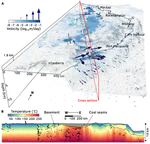
The Underworld project team develops python-friendly geodynamics code which provides a programmable and flexible front end to all the functionality of the code running in a parallel HPC environment. This gives significant advantages to the user, with access to the power of python libraries for setup of complex problems, analysis at runtime, problem steering, and coupling of multiple problems. Underworld code is integrated with the literate programming environment of the jupyter notebook system for tutorials and as a teaching tool for solid Earth geoscience.
The Underworld project builds open-source code for a range of applications, including large-scale geodynamic modelling, landscape evolution, spherical triangulations and data wrangling. Active projects that are under active development include:
- Underworld2: a parallel, particle-in-cell, finite element code for Geodynamics
- UWGeodynamics: a teaching and research tool for numerical geodynamic modelling
- Quagmire: a landscape evolution framework on unstructured meshes
- Stripy: a python module for (constrained) triangulation in Cartesian coordinates and on a sphere
The Underworld development team is based at the Australian National University, University of Melbourne, University of Sydney, and Monash University led by Louis Moresi. We would like to acknowledge AuScope Simulation, Analysis and Modelling for providing long term funding which has made the project possible. Additional funding for specific improvements and additional functionality has come from the Australian Research Council.


